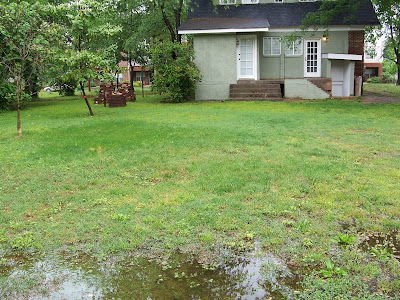
Pictured is a late model 1 gallon Ortho pump sprayer. The spray tip is fully adjustable. A pressure relief valve makes it easy to let off the pressure for refilling. The lightweight, compact design makes for convenient use. Becky bought it at Walmart last summer. I think the sprayer was packaged with a bottle of Roundup like the one in the photo and sold as a weed killing kit. I bought this Roundup at Fuller and Sons Hardware for $12. It makes 2-1/2 gallons of weed killer. I may have gotten a better deal at Walmart.
Having been a painter for so many years I have used all kinds of pump sprayers. I have a 2 gallon Gilmour pump sprayer which I once used to apply cleaning solution to exteriors and applying wall paper remover. I used the heck out of that sprayer. In the paint shop I have an old Hudson steel tank sprayer, about 2 1/2 gallons capacity, which I customized to spray oil on shake shingle roofs when I was out in Wyoming. It's a couple of decades old and I doubt if it still works.
Pump sprayers will work perfectly and last a long time if they are given proper care. After use rinse the jug part thoroughly. Then take the pump mechanism and induce water into it from the top of the pump by directing

the water hose around the pump handle while pumping. The water gets sucked into the top of the pump and sprays out of the bottom. Pump it till the water is out. Take the tip off the sprayer wand and rinse with the water hose to purge the tip. Put some water in the jug, put in the pump, pump it up enough to spray, and then spray to purge the hose. Empty the water and put in fresh and repeat two or three times to make sure the whole thing is rinsed clean. Drain everything well and store the sprayer on it's side or upside down with the pump mechanism stuck in loosely so it will dry. It's kind of a pain to clean the thing out, and you may get your feet wet, but by doing so you can be assured that it will work next time you want to use it. If the sprayer is allowed to get gummed up and dry out for a long time, it will be next to impossible to get it to work properly. Then you will have a piece of junk and you will have to buy a new sprayer. I guess the good

news is that they are less expensive than in the past and more readily available in season. I used to laugh at my brother painters when they'd cuss their pump sprayers because they wouldn't work. They'd beg like dogs to borrow mine. Clean tools which work properly is a point of pride with me.
The weeds are getting high in the alley. Rather than go at them with the string trimmer, I sprayed them with Roundup. I just want fence, gravel and alley back here, no hospitality, and nothing that draws attention to our gate or yard. I used to not be so keen on spraying poison for weed control. That was until last summer when I was employed to keep certain grounds downtown. Part of my job description was spraying weeds growing up in the sidewalks and curbs. Roundup and a pump sprayer is a good system to manage weed control for certain applications in the garden.
When I worked as a grounds keeper last summer we kept a sprayer with Roundup in it at all times since it was used on a daily basis. I don't work like that in my yard. I take one day and hit everything I want to hit all at one time in the morning. It may be weeks until I need to spray again, so I don't keep poison in the sprayer. I use it and clean it.
This type of herbicide kills what's there and then dissipates. The weeds will grow back in a couple of weeks. There is another type of herbicide that lasts the whole growing season. Whichever you use it is best applied when there is no wind, because whatever green thing it hits, it kills. Warmer, dry weather will help to induce the poison into the plants. If you have never used this type of thing before, make sure you read the directions very carefully before you start spraying.
 The giant tree sits on the neighbors lot just on the other side of the property line between us. The ground between the tree and the drive is on our side for the most part. High weeds dominated this area until I took the weed whacker to them.
The giant tree sits on the neighbors lot just on the other side of the property line between us. The ground between the tree and the drive is on our side for the most part. High weeds dominated this area until I took the weed whacker to them. I envision a decorative planting here after getting rid of the weeds and stuff. This patch of ground at the base of this ancient tree has potential in my eyes.
I envision a decorative planting here after getting rid of the weeds and stuff. This patch of ground at the base of this ancient tree has potential in my eyes. This is the most neglected spot in our yard. For the time being I am decided to get after this with loping shears and shrub rake to start cultivating something swell.
This is the most neglected spot in our yard. For the time being I am decided to get after this with loping shears and shrub rake to start cultivating something swell.






















































